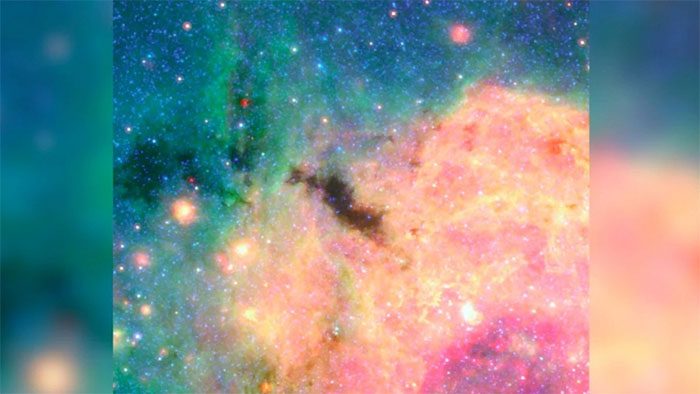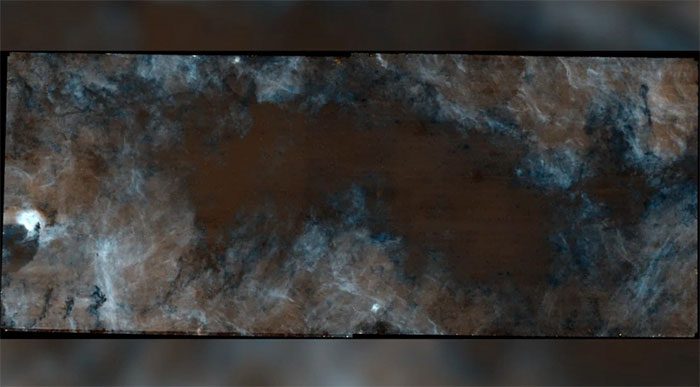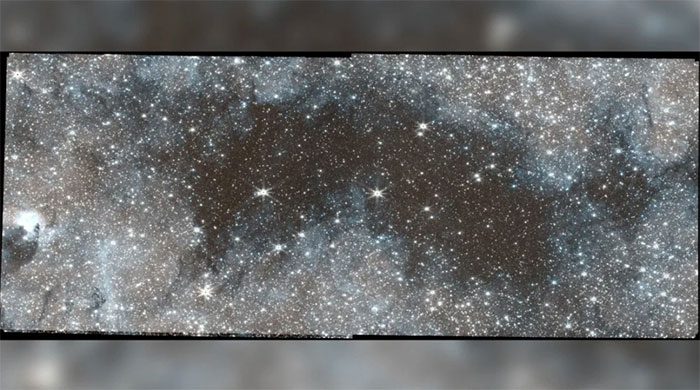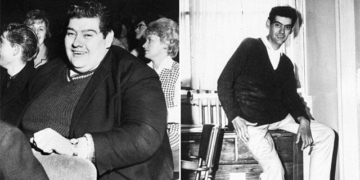A mysterious box-shaped dust cloud at the center of our galaxy has long puzzled scientists, and recent observations revealing new details about its composition are deepening this mystery, potentially reversing our understanding of star formation.
Based on current researchers’ insights into star formation, the cloud, named Brick due to its brick-like shape, was previously estimated to have a mass 100,000 times that of the Sun and was thought to be a factory for producing new, massive stars.
However, the reality is quite different.
Brick is nearly inactive. Recent observations using the James Webb Space Telescope have not revealed any hidden young stars.

The central region of the Milky Way through the lens of the Spitzer Space Telescope. Brick is the dark spot at the center of the image. (Photo: NASA).
New data from James Webb instead reveals that Brick is not solely composed of gas. It also contains frozen CO (carbon monoxide) molecules – significantly more than previously expected, according to a study published in the Astrophysical Journal. Additionally, more ice is forming deep within Brick.
These findings may provide valuable information for scientists to analyze this area in the near future. The presence of more frozen CO inside Brick could significantly change how researchers view and measure the dark clouds at the center of the Milky Way.
“We are now closer to understanding exactly what is happening in Brick and its mass,” said astronomer Adam Ginsburg from the University of Florida, the lead investigator of the study.
One of the perplexing questions for scientists is: Why and where is CO freezing?
Other mysteries surrounding this area remain unanswered: Why can’t we see any new star formation? Is Brick less dense than scientists predicted?
“We have a lot to figure out before we can be truly certain about what is happening. I want to say we are in the hypothesis-forming stage, not the conclusion stage,” Ginsburg stated.
New Data from the James Webb Telescope
Ginsburg and his colleagues first began studying new data from Webb in September 2022.
This was a significant moment. When this world’s most powerful telescope was built, it provided unprecedented images of Brick. However, according to astronomer Ginsburg, “there are too many stars at the center of the galaxy causing confusion.” Therefore, researchers had to spend months filtering the data, orienting it to accurately map the sky. Afterward, they closely examined Brick and discovered that the images from Webb were color-corrected incorrectly.
“All the stars appeared with a bit too much blue,” Ginsburg said. This led researchers to wonder whether there had been an error with the data from James Webb.
However, according to him, it turned out the issue lay with their assumptions. Scientists did not think there was so much frozen CO, which caused the color change.

Image of Brick captured by the James Webb Telescope. This cloud is located near the center of the galaxy, 26,000 light-years from Earth. (Photo: NASA).
According to Dr. Natalie Butterfield from the National Radio Astronomy Observatory, who was not involved in this study, the presence of ice may have caused a ripple effect in some research areas at the center of the Milky Way.
Natalie Butterfield noted that her own research – which includes studies of supernova explosions and radio waves between star systems – could permanently change our understanding of the existence of frozen CO. It may alter how scientists estimate the mass of all clouds in the center of the galaxy.
The Question Behind the Existence of CO
There are several complex issues related to the frozen CO in Brick. For instance, this area is quite warm, at about -213 degrees Celsius, while CO typically freezes at -253 degrees Celsius.
This could mean that the dust inside Brick is colder than the gas, causing CO around dust particles to solidify. Alternatively, according to Ginsburg, it could be that ice is trapping CO inside. The answer to this question is crucial. All the ice in areas like Brick could provide scientists with a new perspective on our Solar System, even our own planet.
For example, the ice and water present on Earth may have arrived here via comets. Therefore, understanding where ice exists in the universe and how it forms could help researchers comprehend where comets come from and how they gather material.
The Mystery of Star Formation in Brick
Additionally, there is a significant mystery as to why there is a lack of star formation in Brick. Scientists understand that new stars form from clouds of dust and hydrogen molecules, but they cannot directly observe these molecules in Brick or anywhere else in the universe because they are invisible to telescopes.
However, scientists also know that each hydrogen molecule likely corresponds to a certain amount of CO. And since CO is visible, scientists can calculate it as a means to determine how many hydrogen molecules are in an area.

Image of Brick captured by the James Webb Telescope. (Photo: NASA)
Researchers have used this method to estimate hydrogen molecules for 50 years. But they always assumed that CO existed in gas form rather than as frozen solid, as revealed by the data from James Webb. This discovery has opened up new questions.
Ginsburg noted that understanding the state of CO – whether solid or gaseous – is crucial for providing accurate answers.
Each new insight into Brick and its composition further clarifies why this obscure cloud is not producing stars, even though it should be one of the most active star-forming nurseries in the galaxy.
“This is a natural place for new stars to be born. But we are not finding many stars; we only see a few, specifically a very small number.”
There are several answers that Ginsburg and his colleagues are considering: “Perhaps Brick is expanding and is less dense than scientists previously thought. Or maybe it is too young, and the star formation stage is still ahead.” In the near future, the James Webb Telescope with its powerful capabilities may provide researchers with more answers.


















































